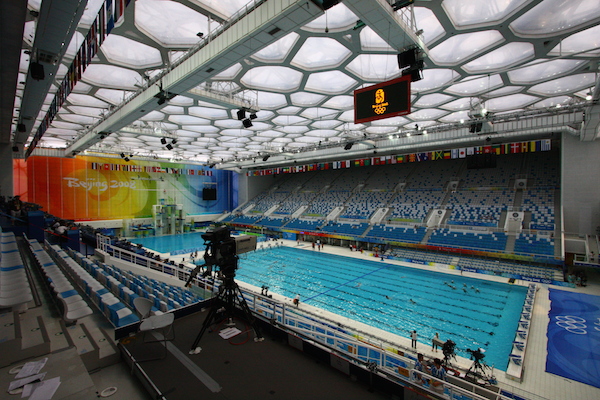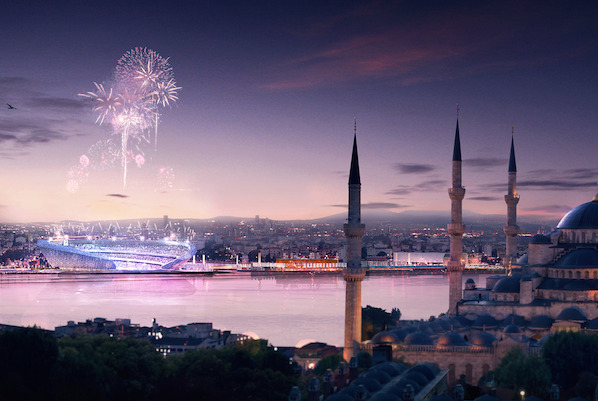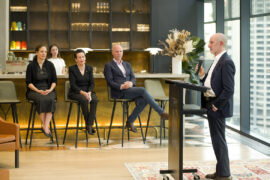Controversy is building around Olympic Games architecture and infrastructure in Rio, and Olympic stadiums in cities such as Athens are falling into disrepair. Sports design expert John Pauline talks about common pitfalls, the value of legacy designs and future innovations.

August 18th, 2016
Top image: The Water Cube, Beijing
Kickbacks, flooding, displaced communities, designs that get scrapped, buildings that run way over budget, and buildings that fall into disuse and disrepair as soon as the events are done. These are some of the issues that plague Olympic architecture, from stadiums to living quarters for athletes. As the Rio 2016 Olympics draw to a close, its design efforts are under scrutiny: was it worth it? What will Rio do next? And what could Tokyo do differently in 2020?
There are few people better placed to answer these questions than John Pauline, Principal at Hassell, an international design practice with offices in Australia, Hong Kong, China, Southeast Asia and the UK. The practice covers everything from urban design to interiors across a range of fields, with one of these being sport and entertainment. Pauline and Glenn Scott, a Principal at Hassell, in the Sydney office, are the driving force in this field, having both worked on a number of Olympic Games in a variety of different capacities. Here, Pauline gives IDLHK his take on Olympics past, present and future.
Which Olympic Games have you worked on?
I’ve been in every Summer Olympics since Sydney, except Tokyo – that’s because we were bidding for Istanbul.
What has your role been at the Summer Olympic Games?
My first was in Sydney starting from 1992. That was as a junior architect: I was literally working on the design and delivery of architectural buildings. I worked on the swimming centre, the athletics centre and also the baseball venue in Sydney. That was actually before Sydney won the Olympics. I was working as part of Sydney trying to win it – they won it in 1993. The IOC (International Olympic Committee) gives each city about seven years to get ready.
Based on the Sydney experience, the company I was working with at the time got the gig to work within the Athens organising committee, advising them on their bid. I went to live in Athens, advising them as a sports expert.
I got the same role in Beijing, but there I was employed as an individual. I was the only sports consultant to work within the Beijing Olympic committee. One of the ones I worked on as a designer was the Water Cube [Beijing National Aquatics Center].

Inside the Water Cube in Beijing
While I was in Beijing, I worked on the London Olympics. I worked on the Copper Box [Arena], the handball and fencing centre, working with MAKE architects remotely.
Then we were engaged to be the only designers to work on the Istanbul bid. This was the first time an Olympic city has engaged one company to do the whole project. Normally they get a whole bunch of architects to work on different parts. The project was incredibly streamlined, very coherent.

Designs for the Istanbul Olympic bid
Istanbul lost out to Tokyo. What’s your view on the 2020 Tokyo Olympic and Paralympic Games?
I love Tokyo. Once we got over the pain of Istanbul not winning, it’s a very good city to lose to. Their masterplan was so strong. It was led by Tadao Ando, in terms of the masterplanning advice for the city. There’s real engagement of the waterfront – it’s regenerating part of the city, which is what all good Olympics should do.
Where do you think other Olympic cities have gone wrong?
I think designers make the mistake of the venue coming first. They’re thinking about it in isolation. Every city that designs these buildings just for that specific month when the games are on is doomed to failure.
How do you ensure each building’s longevity?
Here at Hassell, one of the things we talk about is bringing the public domain first. Leading with the experience of the spectator, of the crowds. The way the venue integrates with the landscape. In some respect the venue comes later.
For example, the Copper Box I worked on for London was designed as a legacy building was aimed at Hackney first. There was a kindergarten, a crèche, a gymnasium and a café. I believe from what I’ve been told that it’s been the most frequently used of the buildings.
The other example is the Water Cube in Beijing. We took a huge risk on that competition. We added a huge percentage of size that wasn’t requested. The Beijing government said, ‘We want an Olympic swimming and diving centre.’ Meanwhile, we added a huge water park with slides and everything. It added a huge cost to the build, but it’s become the biggest water park in Beijing. It’s all about the cafes, the restaurants, the beaches. That’s the way you need to think with these buildings.
How important is context?
Every city is hugely different. Rio is a stunningly beautiful city, and the backdrop is everything. I’m a little worried that the legacy masterplan is not as good as it could be. From where we at Hassell come from, it’s the parks, the outdoor space and the legacy for the community is paramount.
I’m worried that the major Olympic precinct of Rio [Barra] feels like an empty public domain that happens to have permanent contemporary buildings within it.
To Rio’s credit, they’re doing the first temporary aquatic centre. That’s amazing. It’s an 18,000-seat stadium and temporary swimming pool.
What’s happening in some arenas in some cities where they have indoor theatres and arenas, they’re putting swimming pools in so they can host a world championship or Olympic Games. It comes at a high initial cost, but can you imagine the ongoing maintenance cost? It’s huge.
You regard the London 2012 Olympics as standout. How come?
London did an amazing job, it really did. It’s set a high watermark of what a city should do. It’s not perfect, but lots of other cities have fallen short.
London was a really responsible games. It was expensive, but you’re building in London. It was really good in terms of integration within the legacy park.
Where do you predict technology will take the Games?
Building innovations especially with temporary buildings is really exciting. London did a great job with temporary buildings – the basketball centre and the waterpolo venue. It’s just the tip of the iceberg.
I think there’s a real technology interest that’s happening amongst architects, builders and contractors to come up with really innovative ways of solving this problem, because if you build things permanently and then they’re not going to be used, which is a tragedy.
Then there’s augmented reality. Where you’ve got hundreds of thousands of people in the host city watching the games live, but you’ve got billions of people watching it at home. The old way of watching it is TV. From devices to virtual reality headsets and immersive experience… architecture and design needs to respond to that.
INDESIGN is on instagram
Follow @indesignlive
A searchable and comprehensive guide for specifying leading products and their suppliers
Keep up to date with the latest and greatest from our industry BFF's!

Sydney’s newest design concept store, HOW WE LIVE, explores the overlap between home and workplace – with a Surry Hills pop-up from Friday 28th November.

For those who appreciate form as much as function, Gaggenau’s latest induction innovation delivers sculpted precision and effortless flexibility, disappearing seamlessly into the surface when not in use.

For a closer look behind the creative process, watch this video interview with Sebastian Nash, where he explores the making of King Living’s textile range – from fibre choices to design intent.

At the Munarra Centre for Regional Excellence on Yorta Yorta Country in Victoria, ARM Architecture and Milliken use PrintWorks™ technology to translate First Nations narratives into a layered, community-led floorscape.
It’s taken time, but the debate over the proposed re-development of the Perth Foreshore is now really fired up, writes Paul McGillick.
Your are invited to The University of Newcastle 5th year Architecture "Anarchi" Exhibition 2008.
5th year is the final year of the Masters of Architecture degress and the students final major projects will be on exhibition. Please join us for an eveningto celebrate the completionof 5 years hard work.
Refreshments will be served.
The internet never sleeps! Here's the stuff you might have missed

Former INDE Luminary LeAmon joins the Design Institute of Australia (DIA) following more than a decade as the inaugural Curator of Contemporary Design and Architecture at the National Gallery of Victoria (NGV).

The eponymous practice founder reflects on four decades of work in a new book launched by Lord Mayor Clover Moore, tracing lessons from New York to Sydney and revisiting seminal works including 8 Chifley Square and the Andrew “Boy” Charlton Pool.